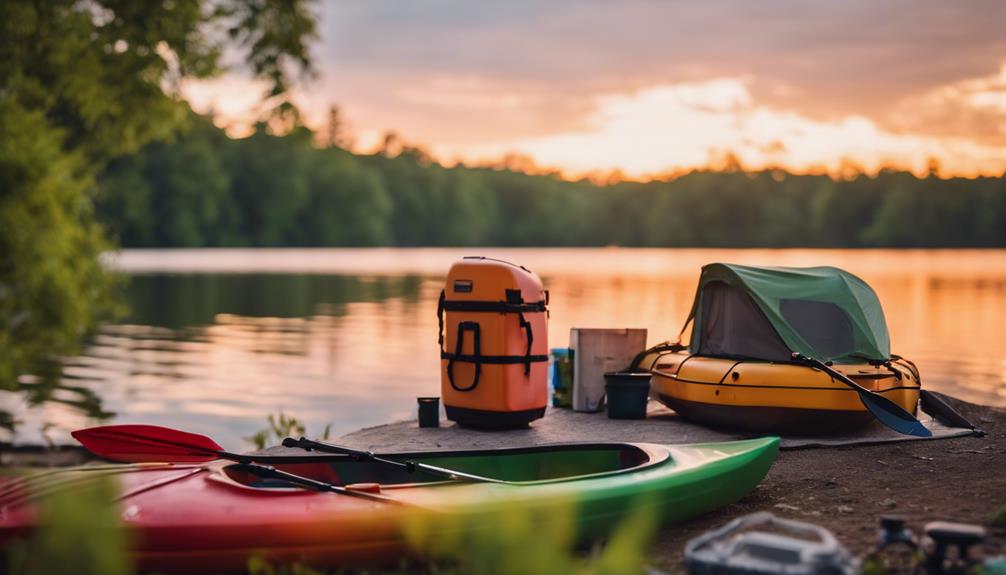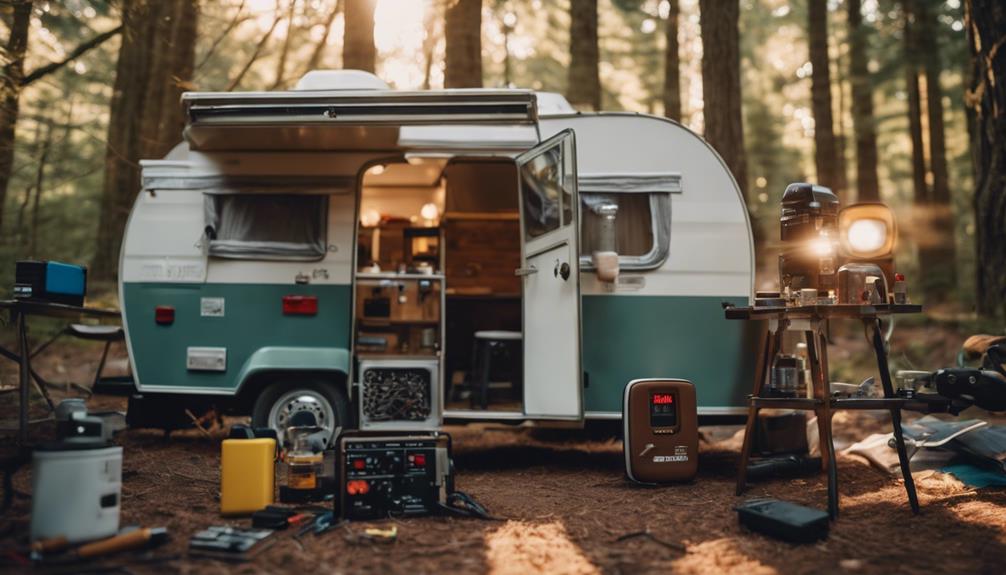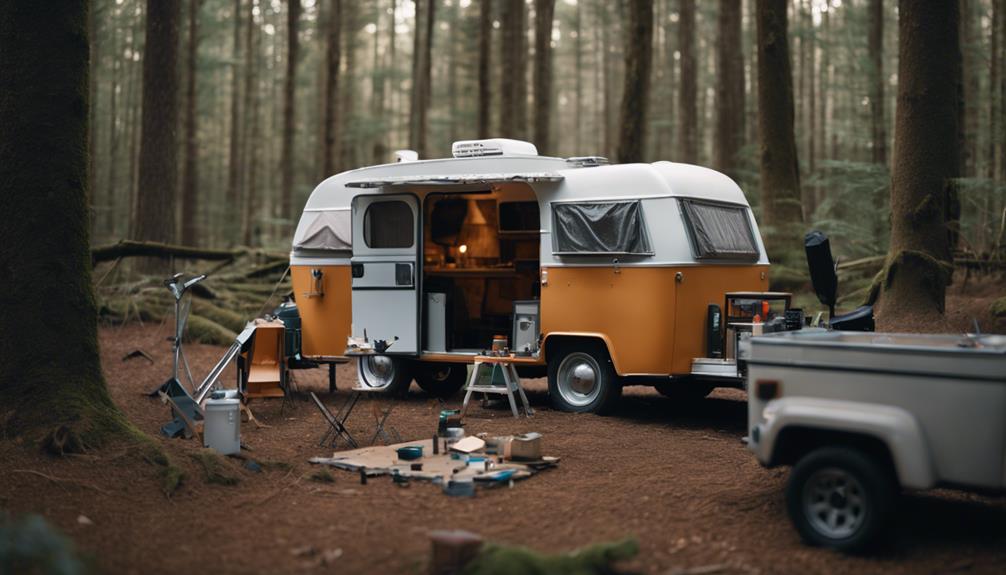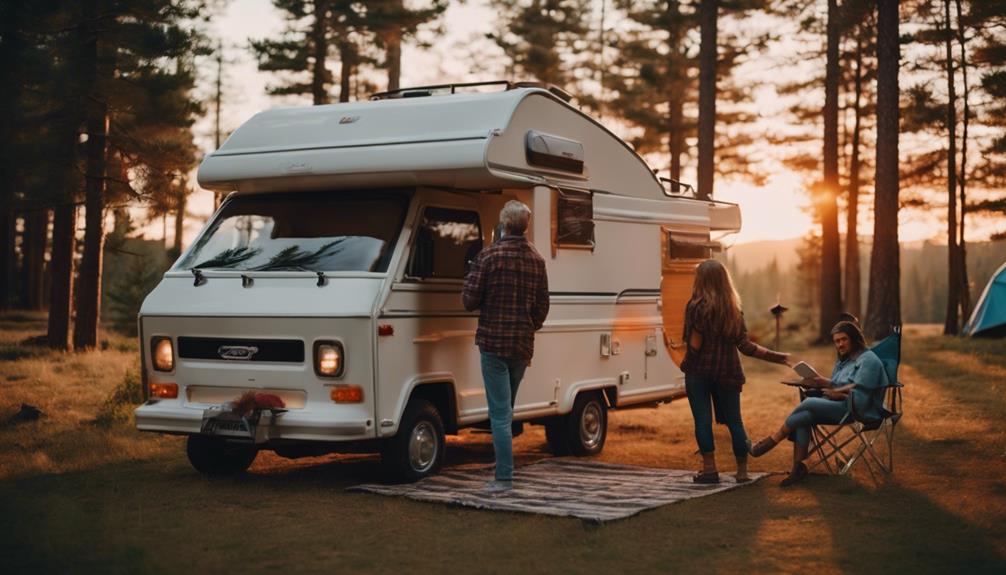Carrying kayaks on a pop-up camper is a fantastic way to enhance your adventures. First, make sure your camper's roof can support the kayaks' weight without exceeding limits. Use a quality kayak carrier from brands like Thule or Yakima, designed for even weight distribution. Secure your kayaks with reliable ratchet straps and add bow and stern lines for extra stability during transit. Always check for tightness and adjust as needed. Don't forget to maintain your kayaks after trips to keep them in great shape. If you stick around, you'll uncover even more tips to make your kayaking trips smoother and safer.
Key Takeaways
- Ensure your pop-up camper's roof can support the weight of kayaks while adhering to manufacturer limits for safety.
- Use lightweight kayaks and gear to optimize towing efficiency and prevent unnecessary strain on the camper's roof.
- Secure kayaks with foam blocks and reliable ratchet straps, and employ bow and stern lines for added stability during transport.
- Distribute kayak weight evenly across the camper roof to avoid structural damage, maintaining 1-1.5 feet clearance for maneuverability.
Preparing Your Pop-Up Camper
Before you hit the road with your kayaks, make certain your pop-up camper's roof is sturdy enough to handle their weight while respecting the manufacturer's specified limits. A strong roof structure is vital for safe kayak transport; exceeding weight limits can cause serious damage.
To optimize stability, consider using lightweight materials for your kayaks and gear. This not only reduces the overall load but also enhances towing efficiency.
When securing kayaks on your roof racks, organize your gear carefully. Use foam blocks or padding to protect the camper's roof and guarantee a snug fit. Regularly check the tightness of your straps to avoid any mishaps during travel. It's important to maintain stability throughout the journey, so inspect the condition of your roof racks frequently.
For better loading efficiency, think about using extension handles or gear reduction mechanisms. These tools can make lifting your kayaks onto the camper roof much easier and safer.
Choosing the Right Kayak Carrier
Choosing the right kayak carrier is essential for guaranteeing your kayaks are safely transported on your pop-up camper without compromising its stability. When selecting a carrier, consider options like foam blocks or racks from manufacturers such as Thule and Yakima. These brands offer solutions that effectively accommodate various kayak sizes and weights while supporting a weight distribution of at least 525 pounds.
Here's a quick comparison to help you decide:
| Feature | Thule | Yakima |
|---|---|---|
| Weight Capacity | 525 lbs | 600 lbs |
| Ergonomic Loading | Yes | Yes |
| Multiple Kayak Support | 3-6 kayaks | 2-4 kayaks |
| Transport Modes | Rooftop, Hitch | Rooftop, Hitch |
Look for carriers that provide ergonomic loading heights to reduce strain while securing your kayaks. Additionally, guarantee your carrier allows for the transport of multiple kayaks simultaneously. Regularly check the integrity of your kayak carrier and its securing mechanisms to ensure safety and stability during travel, especially when hauling longer sea or fishing kayaks.
Securing Your Kayaks Properly

When you're ready to secure your kayaks, it's essential to use the right strapping techniques to keep them in place.
Pay attention to weight distribution and follow safety precautions to prevent any mishaps on the road.
Let's explore how to properly secure your kayaks for a smooth and safe journey.
Essential Strapping Techniques
Securing your kayaks properly is essential for a safe and enjoyable journey, so using reliable ratchet straps is a must. These straps guarantee a tight fit, but be cautious not to apply excessive clamping force, as it could damage your camper's roof.
In addition to ratchet straps, employing bow and stern lines adds extra stability during transport, preventing lateral movement of the kayaks.
Here are some essential tips for securing your kayaks:
- Maintain a clearance of 1-1.5 feet between the kayaks and vehicle for proper maneuverability.
- Regularly check the stability of the straps and racks during stops; make adjustments as needed.
- Consider using foam blocks or pool noodles to provide cushioning between the kayaks and the camper's roof.
- Confirm the kayaks are evenly distributed to enhance stability during transport.
Weight Distribution Tips
To guarantee a safe journey, distribute the weight of your kayaks evenly across the roof of your pop-up camper. It's essential to stay within the roof weight limit, which typically ranges from 100 to 150 pounds, depending on your model. Exceeding this limit can lead to structural damage, so always double-check the weight of your kayaks before loading.
For ideal stability, position the kayaks so that their weight is balanced. Maintain a clearance of 1 to 1.5 feet between the kayaks and the camper to allow for maneuverability. Use a combination of bow and stern lines along with ratchet straps to secure the kayaks firmly. This setup helps prevent lateral movement during transport, enhancing overall stability.
Don't forget to regularly check the tightness of your straps and the stability of the load during stops. Loose straps can lead to shifting kayaks, which poses a risk while driving.
Consider using custom or homemade racks that span from frame to frame for improved weight distribution. This approach can help minimize the risk of roof damage and pooling water, ensuring a smooth adventure ahead.
Safety Precautions Overview
Ensuring your kayaks are properly secured is essential for a safe and enjoyable journey.
When preparing for kayak transport on your pop-up camper, follow these safety precautions to minimize risks and enhance stability.
- Respect the roof weight limits to prevent structural damage.
- Use ratchet straps for securing your kayaks, but avoid excessive clamping force.
- Implement bow and stern lines to enhance stability during travel.
- Conduct regular stability checks on your kayak racks and securing straps.
Safety Tips for Transport
Regularly checking the stability of your rack and straps can prevent accidents and keep your kayak secure during transport. Always verify you maintain a clearance of 1-1.5 feet between the kayak and your vehicle to enhance maneuverability. It's essential to respect the roof weight limits of your pop-up camper; exceeding these can create significant safety hazards while driving.
To guarantee a safe transport experience, consider the following practices:
| Tip | Details | Benefits |
|---|---|---|
| Use Ratchet Straps | Secure your kayak tightly with ratchet straps. | Prevents shifting during transit. |
| Add Bow and Stern Lines | Attach lines to both ends of the kayak. | Enhances kayak stability. |
| Perform Periodic Inspections | Regularly check straps and rack stability. | Identifies potential issues. |
| Check Roof Weight Limits | Comply with your camper's weight specifications. | Avoids structural damage. |
Maintenance and Care for Kayaks

To keep your kayak in top shape, you should regularly inspect it for any signs of wear or damage.
After each use, especially in saltwater, make sure to clean it thoroughly and store it properly to prevent degradation.
Knowing how to handle common repairs can also help prolong your kayak's lifespan and enhance your adventures.
Regular Inspection Practices
Inspect your kayaks for signs of wear, like cracks or scratches, especially after transporting them on a pop-up camper, to maintain their structural integrity. Regular inspection is key to ensuring your kayaks remain safe and functional for your adventures.
Here are some essential practices to follow:
- Check for wear signs after each trip, focusing on areas prone to damage.
- Clean thoroughly to remove dirt and salt, which can cause corrosion over time.
- Store kayaks in a cool, dry place to protect them from temperature fluctuations and UV exposure.
- Learn repair techniques such as patching holes or sealing leaks to address minor issues before they escalate.
Cleaning and Storage Tips
Rinse your kayak with fresh water after every use to prevent saltwater damage and corrosion. This simple step keeps your kayak in top shape.
When it comes to cleaning, use a soft cloth or sponge with mild soap, avoiding harsh chemicals that can harm the finish. After cleaning, make certain to dry it completely to prevent moisture buildup.
For storage, choose a cool, dry place, ideally elevated off the ground. This avoids prolonged contact with moisture that can lead to mold and mildew.
During storage, inspect your kayak regularly for any signs of wear or damage. If you notice any issues, address necessary repairs promptly to maintain its integrity.
To protect your kayak from UV rays and environmental elements, consider using a kayak cover for prolonged storage. This helps prevent fading and deterioration, guaranteeing your kayak stays in good condition for your next adventure.
Community Sharing and Resources
The PopUpPortal community is a treasure trove of shared experiences and practical advice, making it easier for you to navigate the challenges of transporting kayaks on your pop-up camper. With over 412,884 posts, you can find invaluable insights on everything from kayak hauling techniques to loading best practices.
Here's what you can expect from this supportive network:
- Equipment recommendations: Discover the best gear to safely carry your kayaks.
- Safety measures: Learn essential tips to guarantee secure transport.
- Modifications: Get ideas on how to customize your setup for peak efficiency.
- Local regulations: Stay informed about the laws in your area to avoid fines.
Users often share product reviews and personal experiences, helping you make informed decisions. The wealth of information available fosters innovation in transport strategies.
Frequently Asked Questions
Can You Carry a Kayak on a Pop up Camper?
Yes, you can carry a kayak on a pop-up camper, but you need to take into account weight limits and use proper roof racks. Always secure the kayak and check stability during travel to guarantee safety.
How Do You Transport a Kayak on a Camper?
Ever thought about how to transport a kayak on a camper? You'll want to use a roof rack, secure it with straps, and guarantee it's stable during your journey for a hassle-free adventure.
How Do You Transport a Touring Kayak?
To transport a touring kayak, secure it on a roof rack designed for kayaks. Make sure you balance the weight properly, check local regulations, and adjust placement for better fuel efficiency during your journey.
How Do You Carry a Kayak on Top of a Car?
Carrying a kayak on your car can feel intimidating yet exhilarating. Use a sturdy roof rack, center the kayak, secure it with ratchet straps, and regularly check to make certain everything's tight and stable during your journey.
Can Mounting Kayaks on a Pop-Up Camper Affect Enjoying Kayaking Adventures?
Yes, mounting kayaks on a camper can affect enjoying kayaking adventures. While it adds convenience for transportation, it may limit access to certain launch points and make it challenging to reach remote locations. Consider the impact on your overall kayaking experience before deciding to mount kayaks on camper.
Conclusion
Now that you know how to carry kayaks on your pop-up camper, you're ready to begin unforgettable kayaking adventures.
Just imagine gliding across serene waters, surrounded by nature, with your kayaks safely in tow.
By preparing properly and choosing the right equipment, you'll guarantee a smooth journey to your next destination.
So gear up, hit the road, and let the waves call you—your next adventure is just around the corner!











